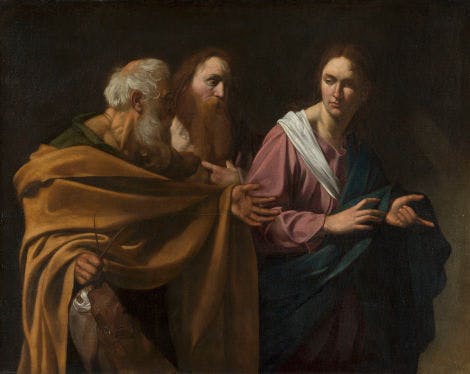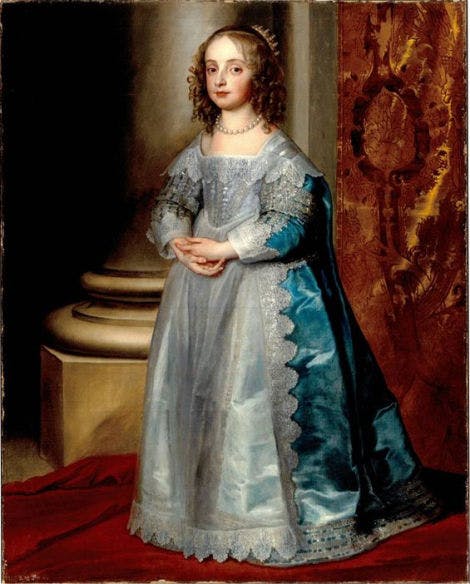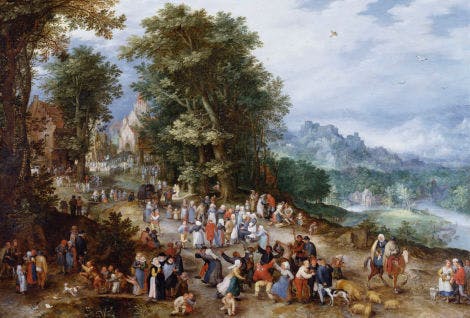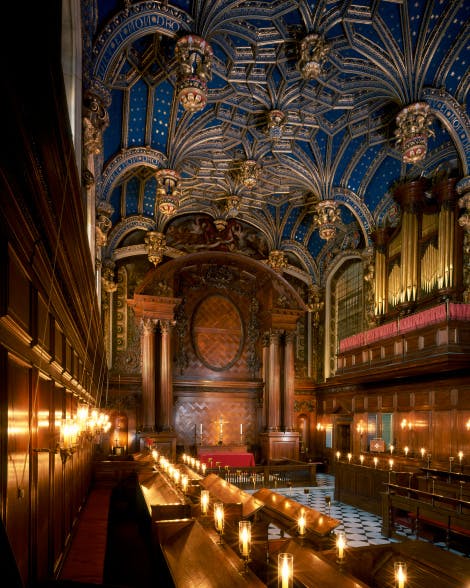

Image: © Royal Collection Enterprises Ltd 2025 | Royal Collection Trust.
Artemisia Gentileschi
Self-Portrait as the Allegory of ‘Painting’, c1638-9
This is one of the most revealing portraits of a 17th-century woman. Artemisia has depicted herself as a working artist and as ‘La Pittura’, the female personification of painting itself – something her male rivals could not do. Artemisia used descriptions of ‘La Pittura’ in ‘emblem books’ that described how she was supposed to look: the artist is lost in the moment, her hair tied back but dishevelled, her body contorted as she concentrates on the canvas.
Canaletto (Giovanni Antonio Canal)
Santa Maria Della Caritá looking towards the bacino c1727-8
Canaletto’s paintings are suffused with Venetian sunlight, minute touches of the paintbrush picking out reflections in the water, and façades of buildings are bathed in light in sharp contrast to walls of dark shadows. In the painting of the Carità, an adjacent building casts its silhouette onto the church, providing a foil to the sunlit figures in the foreground.

Image: © Royal Collection Enterprises Ltd 2025 | Royal Collection Trust.

Image: © Royal Collection Enterprises Ltd 2025 | Royal Collection Trust.
Michelangelo Merisi da Caravaggio
The calling of Saints Peter and Andrew, c1602-04
'Follow me and I will make you fishers of men!' We see the moment just after Christ has spoken, as the impact of his words shows on the incredulous faces of the disciples. Caravaggio has created drama out of a single second. The brothers Peter and Andrew are poised, about to answer Christ’s invitation – their lives will change forever.
Sir Joshua Reynolds
The death of Dido, c1775-81
Artists often turn to the rich mythologies of the ancient world for dramatic stories. This theatrical painting depicts the suicide of Queen Dido of Carthage, abandoned by her lover Aeneas. Reynolds attempts to capture her expression of complete despair, as she writhes in anguish. We are meant to feel the Queen’s pain, and react to the artwork as we would to an actor’s performance on a stage.
Sir Anthony van Dyck
Portrait of Mary, Princess Royal and later Princess of Orange, c1637
Court artists worked directly for the royal family. Van Dyck’s portrait of the 6-year-old daughter of Charles I is a statement of dynastic wealth – the expensive lace, pearls and gold damask curtain – but also a delightful image of a little girl with her hands clasped uncertainly in front of her silver apron, attempting a mature pose beyond her years.

Image: Accepted by HM Government in lieu of Inheritance Tax and allocated to Historic Royal Palaces, 2008
Thomas Gainsborough
Diana and Actaeon, c1785-88
As punishment for spying on her while bathing, the goddess Diana throws water in the face of Actaeon, transforming him into a stag who is destined to be killed by his own dogs. Gainsborough blended the figures into the landscape to evoke the mystery and power of nature, an approach that reaches back to Titian and forward to Renoir, Cézanne and Matisse.

Image: © Royal Collection Enterprises Ltd 2025 | Royal Collection Trust.
Rembrandt van Rijn
An old woman, called ‘The Artist’s Mother’, c1627-9
Rembrandt’s painting is a timeless and moving record of old age. The hooded eyes, thinning lips and the loose and creased folds of skin are all exaggerated and highlighted, designed to evoke our pity and perhaps a sense of our own mortality. Such paintings, virtuoso exercises of imagination, also brilliantly displayed Rembrandt’s talent, and helped establish his reputation.
Jan Brueghel the Elder
A Flemish fair, 1600
Brueghel’s colourful depiction of a street party is also a celebration of the happiness of a society at peace. The Dutch Republic had declared independence from Spanish rule in 1581, heralding a ‘Golden Age’ of Dutch art and culture. This painting is a statement of national pride. It shows how a well-ordered society should be, but it is also an incident-packed description of town life, full of delightful detail.

Image: © Royal Collection Enterprises Ltd 2025 | Royal Collection Trust.

Image: © Royal Collection Enterprises Ltd 2025 | Royal Collection Trust.
Frank Holl
No tidings from the sea, 1870
Victorian artists drew on a long legacy of narrative art. This painfully emotional scene captures a family’s desolation after the death of a fisherman. Holl’s muted colours and the quiet grief of each of the figures is relieved only by the mystical light around the bright white shirt of the young girl, a sign of hope and an echo of the religious symbolism of earlier artworks.
Duccio di Buoninsegna
Triptych: Crucifixion and other scenes, c1302-08
Sacred paintings have helped Christians understand the important principles of their faith, for 2,000 years. In this 14th-century depiction of the death of Christ, the Sienese artist Duccio has placed Christ’s mother, the Virgin Mary, four times, skilfully painting her emotions so that the viewer can identify with her story. This altarpiece was for private use; its hinged sides originally closed like doors to protect the painting. When opened for prayer by candlelight, the gold leaf glowed and shimmered, evoking the riches of heaven.

Image: © Royal Collection Enterprises Ltd 2025 | Royal Collection Trust.
Explore what's on

- Things to see
Cumberland Art Gallery
Discover masterpieces by Rembrandt, Caravaggio, van Dyck, and more at the Cumberland Art Gallery at Hampton Court Palace.
-
Open
- In line with palace opening hours
- Hampton Court Palace
- Included in palace admission (Members go free)

- Things to see
Great Fountain Garden and the Long Water
Enjoy the splendour of these water features fit for royalty.
-
Open (Closed 08 and 13 March 2026)*
- In line with palace opening hours
- Hampton Court Palace
- Included in palace admission (Members go free)

- Things to see
Mantegna Gallery
The Mantegna Gallery is closed for maintenance work until 2026. Two paintings from The Triumphs of Caesar can be seen in the Queen’s Presence Chamber (part of The Georgian Story) during this period.
- Closed for maintenance
- Hampton Court Palace
- Included in palace admission (Members go free)
Browse more history and stories

Art at Hillsborough Castle
Hillsborough Castle has become a place in which to see amazing art

William Kent
Royal artist, architect and designer to Georgian kings

The story of Hampton Court Palace
Home of Henry VIII and the Tudor dynasty


